5 heritage sites in Rajasthan under ₹10,000
5 heritage sites in Rajasthan under ₹10,000
(Assumption: your target budget is ₹10,000 per site for a comfortable day-trip or short overnight visit for one person, including entry fees, local transport from the nearest city, a budget guesthouse (or simple hotel) for one night, where helpful, basic meals, and modest extras like a guide or camera fee. Where official entry fees are available, cite them. Costs such as transport and food are estimated conservatively; always book and check current prices before travel.)
Rajasthan is a living museum — forts, palaces and walled cities that have survived centuries of dynastic drama, art and desert wind. You can have an unforgettable heritage experience without breaking the bank. Below are five iconic sites, why each is memorable, practical visiting tips, and a budget-friendly sample cost plan that keeps the total below ₹10,000.
1) Amber (Amer) Fort — Jaipur: hilltop palaces, mirror work and elephant lore

Why go: Amer (commonly called Amber) is the postcard Jaipur fort: high ramparts, the Sheesh Mahal (mirror palace), broad courtyards and views over Maota Lake. The fort’s scale and Mughal-Rajput blending make it a perfect intro to Rajasthani royal architecture.
What to see & do: Walk through the Suraj Pol (Sun Gate), climb into Ganesh Pol and the Sheesh Mahal, stroll the private royal chambers and gardens. If you like photos, arrive early for soft morning light and fewer crowds. There’s also an evening light-and-sound show on many nights (small additional fee); elephant rides have resumed but prices and availability change — check on the day.
Practicalities & timings: Typical opening hours are early morning to early evening (roughly 8:00–17:30/18:00). Official entry fees reported by Jaipur tourism list modest charges for Indians (often around ₹100) and higher for foreign visitors — check the official Rajasthan booking portal for live tickets. Guided tours and audio guides are available.
Sample budget (solo, Jaipur base; day + one night):
- Entry ticket: ₹100 (Indian adult) — if foreigner, adjust.
- Local roundtrip transport (auto/taxi within Jaipur + short ride to Amer): ₹800–1,200
- Simple guesthouse (1 night, good budget option): ₹800–1,200
- Meals and water: ₹500–700
- Guide/audio or small extras (camera fee, donations): ₹200–400
Estimated total: ₹2,400–3,600 (well under ₹10,000)
Insider tip: Combine Amber with Hawa Mahal and City Palace sightseeing in Jaipur for a compact two-day circuit; book tickets online to skip ticket queues.
2) Jaisalmer Fort (Sonar Quila) — Jaisalmer: the Golden Fort that lives inside a city
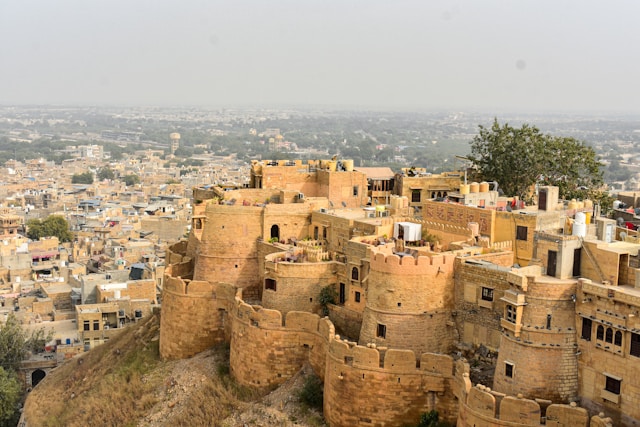
Why go: Jaisalmer Fort is unusual — a massive sandstone citadel that still houses people, shops, and homes within its ramparts. By late afternoon, the fort glows golden, and the narrow lanes, havelis (merchant mansions), and rooftop cafés give a cinematic desert-kingdom feel.
What to see & do: Explore the fort’s four triangular bastions, visit the small but evocative Jain and Hindu temples inside, tour the Fort Museum and climb to rooftop viewpoints at sunset. Nearby, traditional havelis such as Patwon Ki Haveli and Nathmal Ki Haveli are quick side trips. Consider a short camel safari at Sam Sand Dunes if you want the full desert experience (typically a separately priced package).
Practicalities & timings: Official local pages commonly list Jaisalmer Fort’s entry at a very modest price (for Indian nationals around ₹50 and for foreigners around ₹250 — camera fees extra in some cases). The fort is open during daylight hours (roughly 9:00–17:00). Because the fort is inhabited, be respectful of residents’ privacy.
Sample budget (solo, Jaisalmer base; day + one night):
- Entry ticket: ₹50 (Indian) + small camera fee if needed (₹50) — adjust for foreigners.
- Local transport/tuk-tuk: ₹400–800
- Budget guesthouse/hostel (1 night): ₹600–1,200
- Meals and chai/refreshments: ₹400–600
- Optional small item (handicraft purchase or local guide): ₹300–500
Estimated total: ₹1,800–3,300
Insider tip: Sunset from a rooftop café inside the fort or from Bhatia Bazaar’s viewpoint is magical — buy chai and watch the fort turn from honey to burnished gold.
3) Mehrangarh Fort — Jodhpur: dramatic walls and royal galleries

Why go: Mehrangarh dominates Jodhpur — thick cliffs, soaring walls and museum galleries full of royal weaponry, textiles and palanquins. The viewpoint back toward the “blue city” is one of Rajasthan’s best photo compositions.
What to see & do: Visit the Palanquin Hall, Sheesh Mahal, and the Mehrangarh Museum (one of India’s better private fort museums). The fort complex also has excellent guided tours and audio guides; there are cafés with views and occasional cultural programs. Don’t miss Jaswant Thada (nearby marble cenotaph) for a short, peaceful detour.
Practicalities & timings: Mehrangarh’s ticketing varies by visitor type; the official museum/fort site shows different guided-tour and group pricing, and audio guides are commonly offered. Domestic and international ticket rates differ, and there are concessions for students and seniors — check the official Mehrangarh site before visiting.
Sample budget (solo, Jodhpur base; day + one night):
- Entry + basic audio guide: ₹200–600 depending on type (Indian visitor vs special guided tour).
- Local transport within Jodhpur: ₹400–800
- Budget hotel (1 night): ₹700–1,300
- Meals & incidentals: ₹500–700
- Optional cultural show or small purchase: ₹300–500
Estimated total: ₹2,100–3,900
Insider tip: Arrive late afternoon to enjoy golden light on Mehrangarh, then dine at a rooftop restaurant overlooking the blue houses of the old city.
4) City Palace — Udaipur: lakeside palaces, courtyards and museum rooms
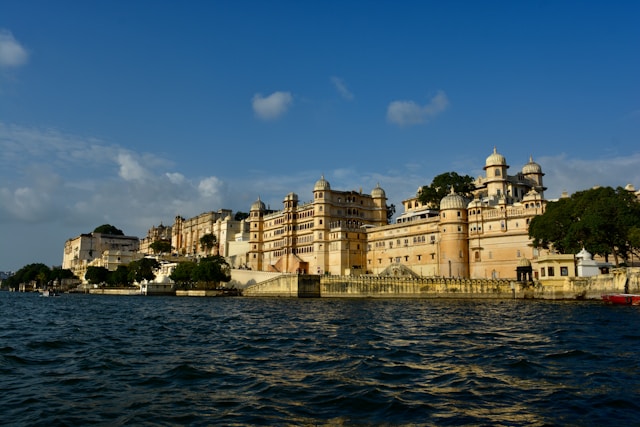
Why go: The City Palace in Udaipur perches above Lake Pichola, a layered complex of palaces, balconies and courtyards in an intimate lakeside setting — think ornate balconies, mirror work and miniature paintings. It’s the showpiece of romantic Udaipur.
What to see & do: Tour the palace museum, the Zenana Mahal (women’s quarters), and the crystal gallery (if open). From the palace steps, you can take short boat rides on Lake Pichola for postcard views of Jag Mandir and the city skyline. Evening light and a lakeside dinner make Udaipur feel cinematic.
Practicalities & timings & fees: Published local sources show varied fees; many City Palace pages list domestic fares that are modest (examples vary, so check the official City Palace Museum site for updated prices). Camera fees can apply, and combined boat-plus-palace packages are commonly available.
Sample budget (solo, Udaipur base; day + one night):
- Palace entry: ₹200–600 (depending on type and concessions).
- Short boat ride on Lake Pichola (shared): ₹200–400
- Local transport: ₹300–700
- Budget hotel (1 night): ₹800–1,400
- Meals & incidentals: ₹500–700
Estimated total: ₹2,000–3,800
Insider tip: Combine a late-afternoon palace visit with an evening boat ride — the palace lit at night reflecting on Pichola, is a highlight of Udaipur.
5) Chittorgarh Fort — Chittorgarh: epic history, heroic tales and ramparts
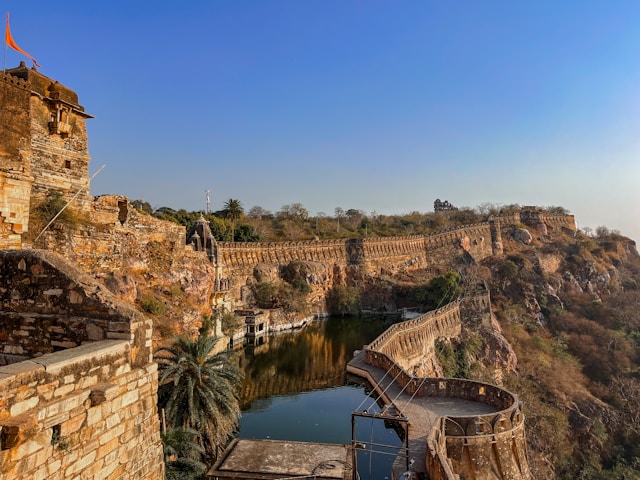
Why go: Chittorgarh is Rajasthan’s largest fort complex and a symbol of Rajput valour and sacrifice — vast ruins, towers, palaces, and memorials across a huge hilltop plateau. It’s less tourist-crowded than Jaipur or Udaipur and rewards time and curiosity.
What to see & do: Climb to the Vijay Stambh (Victory Tower), visit Rana Kumbha’s palace ruins, explore the temples and cenotaphs, and take in plateaus with panoramic views. The scale of the place makes it a full-day experience.
Practicalities & timings & fees: Local tourism sources routinely list very modest Indian-visitor fees for the fort (often ₹20–₹40), with higher foreign fees in some listings. The fort is generally open daily during daylight hours — plan a full day and take water and sun protection.
Sample budget (solo, base in Chittorgarh or nearby Udaipur; day + one night):
- Entry ticket: ₹20–50 (Indian) — foreigners may pay more.
- Local transport/taxi for hill approach: ₹400–900
- Budget guesthouse (1 night): ₹600–1,200
- Food & water: ₹400–600
- Guide or small donation: ₹200–400
Estimated total: ₹1,620–3,150
Insider tip: Because Chittorgarh is sprawling, hire a local guide for 2–3 hours if you want context; otherwise, allow extra time for independent exploration.
Planning notes & smart saving tips (so you stay under ₹10,000)
- Travel in shoulders/seasons: Avoid peak holiday weekends — fares for trains and flights, and hotel rates spike. Rajasthan’s shoulder months (late Sept–Nov and Feb–Mar) give great weather and lower crowds.
- Use trains and state buses: For inter-city travel, trains and state buses are far cheaper than taxis. Reserve early for AC sleeper if comfortable — a good balance of cost and comfort.
- Pick budget stays with local character: Guesthouses, haveli B&Bs and family-run hotels often cost ₹600–1,300 and have a strong local flavour. Book ahead if you travel on weekends.
- Combine nearby sites: Many of these sites pair naturally — Jaipur (Amber + City Palace + Hawa Mahal), Jodhpur (Mehrangarh + Jaswant Thada), Udaipur (City Palace + boat ride). Grouping saves transport days and money.
- Carry cash for small vendors: Some local fees (camera fees, small temple donations, local guides) may prefer cash — keep small notes.
- Book official tickets online where available: Reduces time in queues and sometimes gives fixed, transparent pricing (Rajasthan’s official booking portal lists many monuments).
Quick citation summary (most load-bearing sources used)
- Amber Fort / Amer: Jaipur tourism / official pages showing entry fees and visitor info.
- Jaisalmer Fort: Jaisalmer tourism and local guides listing entry fees and timings.
- Mehrangarh Fort: Official Mehrangarh Museum/fort visitor pages explaining ticketing and audio/guided options.
- City Palace (Udaipur): Udaipur tourism / City Palace Museum pages with visiting info and ticketing.
- Chittorgarh Fort: Rajasthan tourism entries give practical timings and low domestic entry fees.
Final checklist before you go
- Double-check current entry fees and timings on the official site or local tourism page for the monument you plan to visit (prices do change).
- Carry a reusable water bottle, sunscreen, a light scarf (for sun/dust), comfortable walking shoes and ID (some forts check ID for ticketing).
- If you’re a foreign visitor, check the listed foreigner pricing — many Rajasthan monuments charge higher foreign entry fees; factor this into your ₹10,000 planning.
Which would you like next?
FAQ on Heritage Sites in Rajasthan
1. Why is Rajasthan famous for its heritage sites?
Rajasthan is renowned for its rich royal history, magnificent forts, grand palaces, and centuries-old temples. The state reflects the glory of Rajput kings through architectural marvels, traditional art, and vibrant culture.
2. How many UNESCO World Heritage Sites are there in Rajasthan?
Rajasthan has eight UNESCO World Heritage Sites, including:
- Jaipur City
- Hill Forts of Rajasthan (Chittorgarh, Kumbhalgarh, Ranthambore, Amber, Jaisalmer, and Gagron)
- Keoladeo National Park (Bharatpur Bird Sanctuary)
3. What are some must-visit heritage forts in Rajasthan?
Some of the most iconic forts include:
- Amber Fort (Jaipur)
- Mehrangarh Fort (Jodhpur)
- Chittorgarh Fort
- Kumbhalgarh Fort
- Jaisalmer Fort
These forts showcase Rajput military architecture and royal grandeur.
4. Which palaces in Rajasthan are popular among tourists?
Rajasthan boasts many royal palaces such as:
- City Palace (Jaipur and Udaipur)
- Lake Palace (Udaipur)
- Umaid Bhawan Palace (Jodhpur)
- Hawa Mahal (Jaipur)
Each palace offers a glimpse into royal lifestyles and intricate Rajasthani artistry.
5. Are there any heritage hotels in Rajasthan?
Yes, many former palaces and havelis have been converted into luxury heritage hotels. Notable ones include:
- Taj Lake Palace, Udaipur
- Samode Palace, Jaipur
- Neemrana Fort Palace
These provide a royal experience with traditional hospitality.
6. What is special about the City of Jaipur as a UNESCO World Heritage Site?
Jaipur, known as the Pink City, was recognized for its unique urban planning based on Vedic architecture. It’s famous for its pink-hued buildings, grand bazaars, and landmarks like Hawa Mahal and Jantar Mantar.
7. What are the Hill Forts of Rajasthan?
The Hill Forts of Rajasthan are a group of six majestic fortifications — Chittorgarh, Kumbhalgarh, Ranthambore, Amber, Jaisalmer, and Gagron — inscribed as UNESCO World Heritage Sites for their Rajput military design and historical importance.
8. Are there any ancient stepwells or havelis worth visiting?
Yes, notable examples include:
- Chand Baori (Abhaneri) – one of the deepest stepwells in India
- Patwon Ki Haveli and Salim Singh Ki Haveli (Jaisalmer) – fine examples of intricate sandstone carvings
9. Which is the oldest heritage site in Rajasthan?
Chittorgarh Fort is among the oldest, dating back to the 7th century. It represents the bravery and sacrifice of Rajput rulers and queens, especially the legend of Rani Padmini.
10. When is the best time to visit Rajasthan’s heritage sites?
The best time to visit is October to March, when the weather is pleasant for exploring forts, palaces, and desert cities.
11. Are guided tours available for heritage sites?
Yes, most major forts and palaces offer audio guides, local guides, and heritage walks that narrate the historical and architectural significance of each site.
12. What is the entry fee for visiting Rajasthan heritage sites?
Entry fees vary by site and visitor type (Indian or foreign). For example:
- Amber Fort: ₹100 (Indians), ₹500 (foreigners)
- City Palace Jaipur: ₹200–₹300
- Mehrangarh Fort: ₹150 (Indians), ₹600 (foreigners)
13. Are there any heritage festivals in Rajasthan?
Yes, major heritage-related festivals include:
- Rajasthan International Folk Festival (Jodhpur)
- Udaipur World Music Festival
- Jaipur Literature Festival
These celebrate Rajasthan’s cultural and artistic legacy.
14. Which city in Rajasthan has the most heritage sites?
Jaipur and Udaipur are among the richest cities in heritage attractions, featuring multiple forts, palaces, and museums.
15. How can tourists contribute to heritage conservation?
Tourists can help by:
- Respecting local rules and not damaging structures
- Avoiding littering in heritage zones
- Supporting local crafts and eco-friendly tourism initiatives

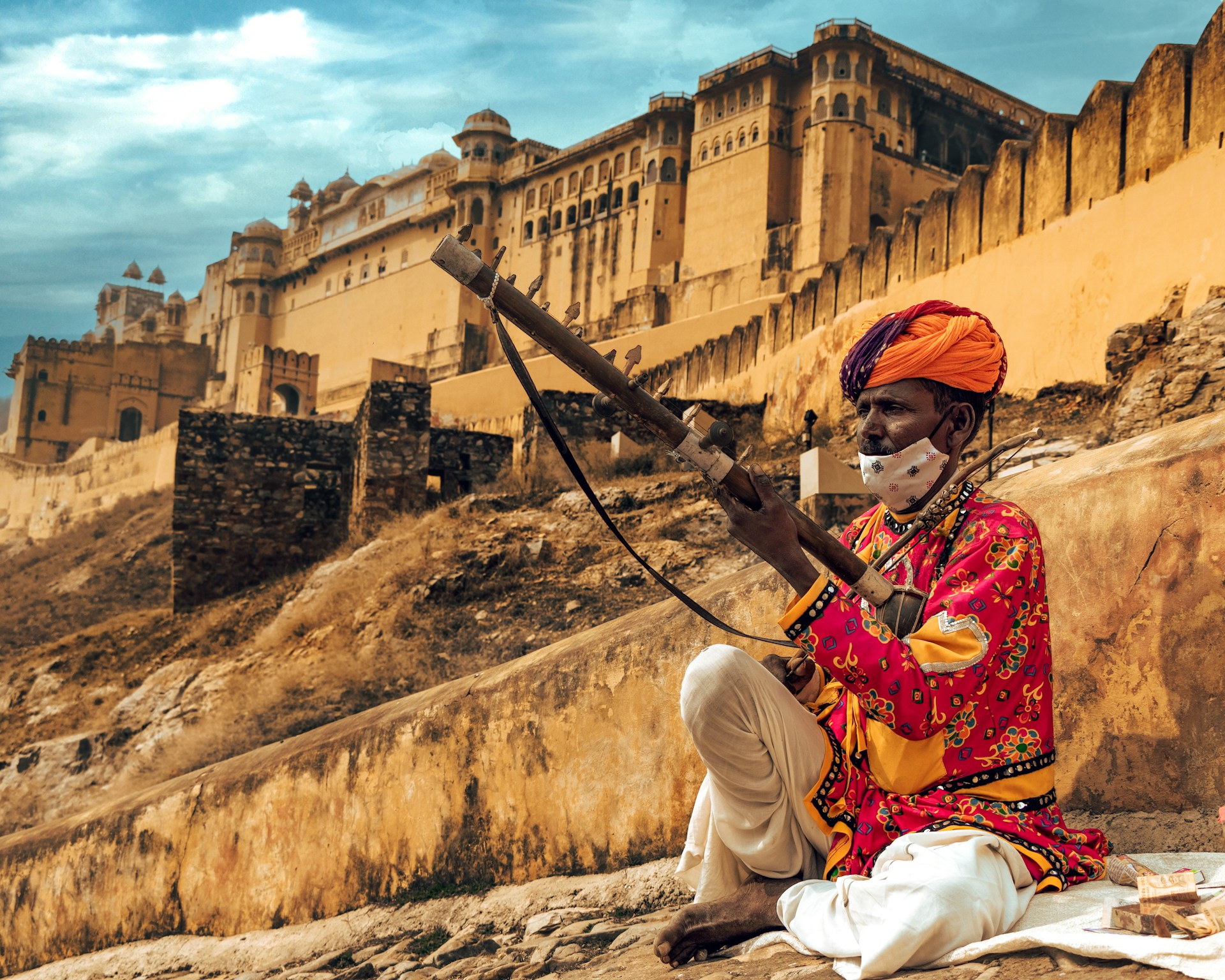
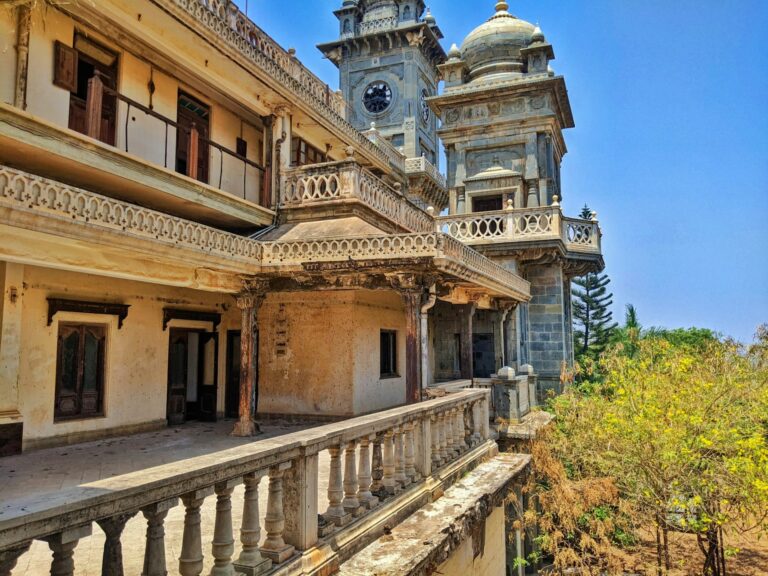
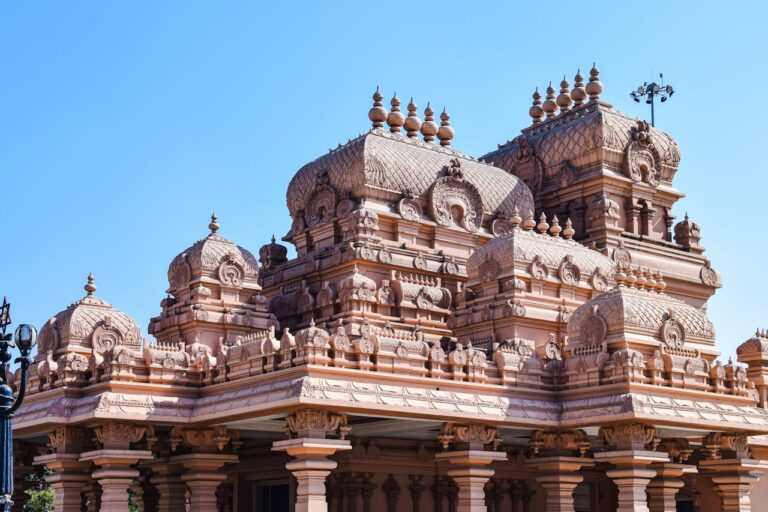
5 Comments